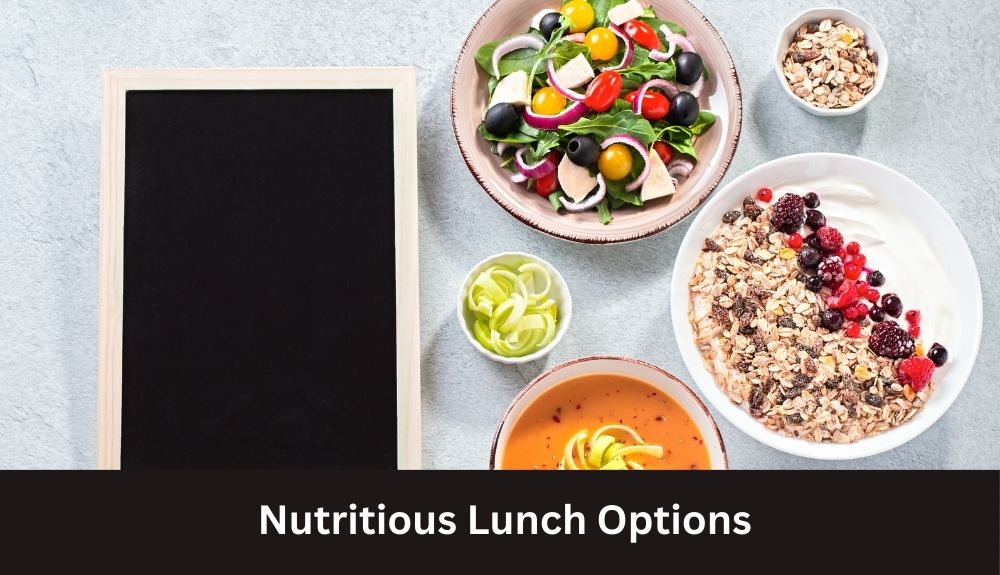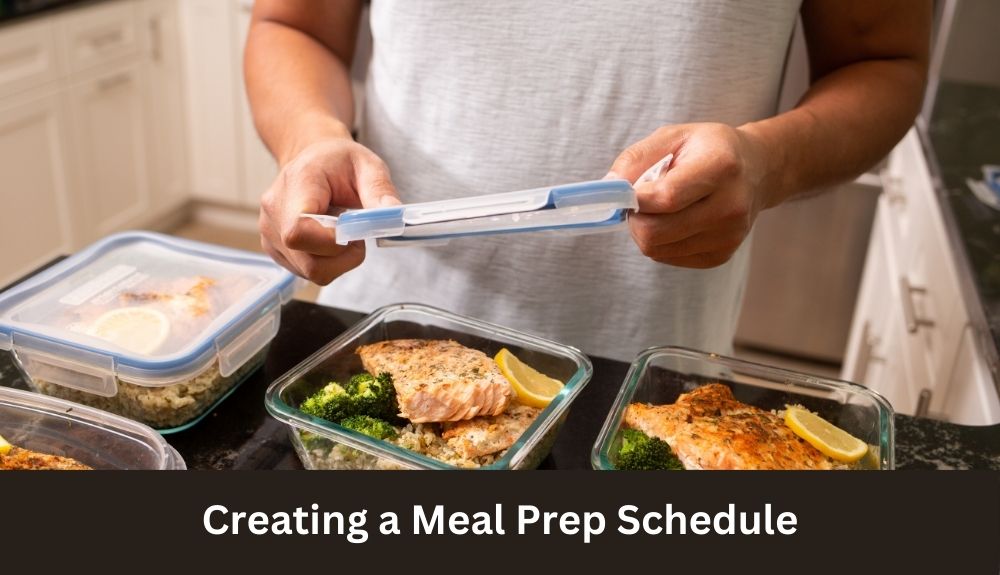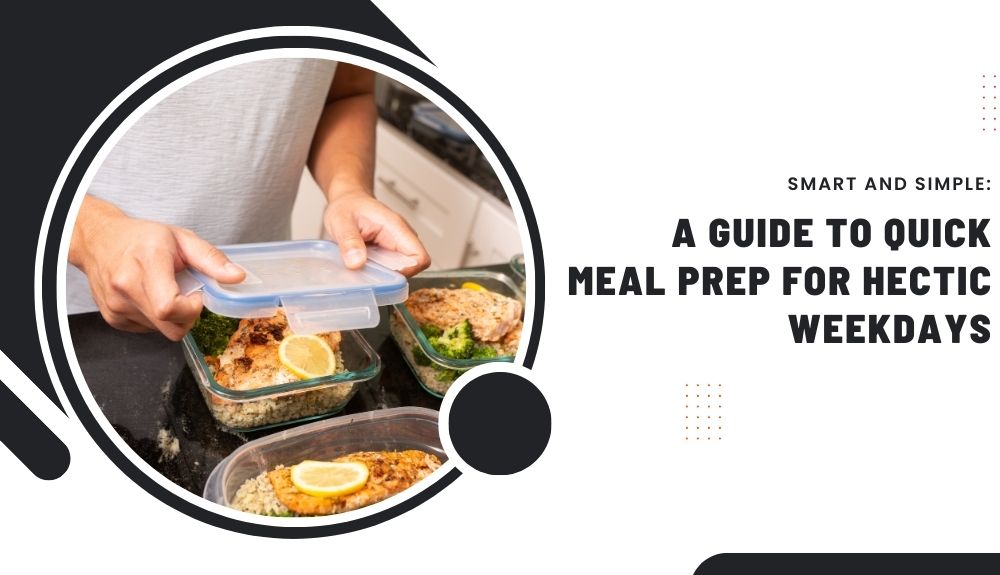Are you tired of scrambling to make dinner after a long day at work? Do busy weekdays leave you feeling frazzled and overwhelmed? If so, you’re not alone. Many people struggle to find the time and energy to cook healthy meals during the week. But fear not! In this blog, we will dive into the wonderful world of quick meal prep, showing you how to save time, reduce stress, and still enjoy delicious, nutritious meals.
Throughout this guide, we will explore smart and simple meal prep strategies that will revolutionize your weekday routine. Whether you’re a beginner or a seasoned pro, you’ll find practical tips and tricks to make meal prep a breeze. We’ll discuss time-saving techniques, budget-friendly ingredients, and mouthwatering recipes that will please even the pickiest eaters.
With our step-by-step instructions and helpful suggestions, you’ll learn how to streamline your meal prep process, plan your menu efficiently, and create mouthwatering meals that can be enjoyed throughout the week. No more last-minute scrambles or unhealthy takeout options – we’ve got you covered!
Get ready to reclaim your weeknights and discover the joy of stress-free, quick meal prep.
1. Benefits of Meal Prep
Meal preparation, or “meal prep,” is a smart and simple solution for busy individuals who find it challenging to prepare meals from scratch on hectic weekdays. By dedicating a small amount of time to meal prep, you can enjoy numerous benefits that will make your life easier and healthier.
1. Time-saving:
Meal prep allows you to spend less time in the kitchen during busy weekdays. By carving out a few hours on the weekend or a less hectic day, you can prepare multiple meals in advance and store them for the entire week. This means you can skip the daily hassle of meal planning, grocery shopping, and cooking after a long day at work. Instead, you can simply reheat and enjoy your pre-prepared meals, saving you valuable time and energy.
2. Money-saving:
Engaging in meal prep can lead to significant savings in your food budget. By buying ingredients in bulk and planning your meals in advance, you can avoid unnecessary trips to the grocery store and reduce food waste. Additionally, by opting for homemade meals, you can save money that would have otherwise been spent on take-out or restaurant meals.
3. Healthier choices:
When you meal prep, you have control over the ingredients you use, enabling you to create nutritious and well-balanced meals. By carefully planning your meals in advance, you can incorporate a variety of vegetables, lean proteins, whole grains, and healthy fats. This ensures that you have a well-rounded and nourishing diet throughout the week. Meal prep also helps you avoid temptations for unhealthy fast food or processed meals when you are pressed for time.
4. Portion control:
Portion control is a crucial aspect of maintaining a healthy diet. When you prep your meals in advance, you can portion them out into appropriate servings, preventing overeating and mindless snacking. Having pre-portioned meals also makes it easier to track your calorie intake and stick to your dietary goals.
5. Reduced stress:
One of the most significant benefits of meal prep is the reduction in weekday stress. Knowing that you have healthy and delicious meals waiting for you at home makes it easier to stay on track with your dietary goals. With meal prep, you no longer have to worry about making last-minute food decisions or resorting to unhealthy options due to lack of time. Instead, you can focus on other important aspects of your life, knowing that you have nourishing meals ready to go.
2. Planning Your Meals
Meal planning is a crucial step in mastering the art of quick meal prep for hectic weekdays. By taking the time to plan ahead, you can save valuable time during the week and ensure that you have nutritious meals ready to go. Here are some essential tips and strategies to help you plan your meals effectively:
1. Set Aside Time for Meal Planning: Dedicate a specific time each week to meal planning. This can be on a weekend or a day when you have some free time. Use this time to brainstorm meal ideas, create a shopping list, and prepare a rough schedule for the week.
2. Take Inventory of Your Pantry and Fridge: Before you start planning your meals, check what ingredients you already have on hand. By taking stock of your pantry and fridge, you can utilize existing items and minimize food waste. Make a list of ingredients that need to be used up and incorporate them into your meal plan.
3. Consider Your Schedule: Take into account your weekly schedule, including work commitments, appointments, and any other events that may affect your meal times. Think about the days when you’ll have more time to prepare meals and when you’ll need something quick and easy. This will help you plan meals that align with your daily activities.
4. Choose a Variety of Recipes: Incorporate variety into your meal plan to keep things interesting. Select a mix of recipes that include different proteins, vegetables, and grains. Aim for a balance of flavors, textures, and colors to make your meals appealing and enjoyable.
5. Make a Detailed Shopping Once you have planned your meals, create a comprehensive shopping list. Include all the ingredients you’ll need for the week, making sure to note any specific quantities. Having a well-organized list will save you time at the grocery store and ensure you have everything you need.
6. Prep Ingredients in Advance: To further simplify your weekday meal prep, consider prepping ingredients in advance. Chop vegetables, marinate meats, or cook grains and store them in airtight containers in the refrigerator. This way, you can save time during the week by simply assembling and cooking your prepared ingredients.
7. Batch Cook Whenever Possible: Batch cooking is a time-saving technique where you cook larger quantities of certain dishes and then portion them out for several meals. For example, you can cook a big batch of chili or stir-fry and divide it into individual servings for the week.
3. Essential Tools for Meal Prep
Meal prep can be a breeze when you have the right tools at your disposal. Here are some essential items you’ll want to have in your kitchen to make your meal prep sessions efficient and enjoyable:
1. Quality Knives: A sharp set of knives is an absolute must-have for meal prep. Invest in a good chef’s knife, a paring knife, and a serrated knife. These will help you slice, dice, and chop your ingredients with ease.
2. Cutting Boards: To maintain proper sanitation and prevent cross-contamination, it’s essential to have multiple cutting boards. Opt for boards made of high-quality materials like bamboo or food-grade plastic. Having different boards for meats, vegetables, and fruits will ensure safety and hygiene.
3. Glass Storage Containers: Invest in a set of glass storage containers with leak-proof lids. Glass containers are more durable, easy to clean, and microwave-safe compared to their plastic counterparts. They also keep your food fresh for longer periods.
4. Meal Prep Containers: These are specifically designed to portion out your meals for the week. Look for containers that are stackable, freezer-safe, and microwave-safe. Having pre-portioned meals will save you time and help you maintain a balanced diet.
5. Slow Cooker or Instant Pot: These versatile appliances are excellent for meal prep as they allow you to prepare a variety of dishes with minimal effort. Using a slow cooker or an Instant Pot can save you time and provide you with delicious, ready-to-eat meals at the end of a busy day.
6. Measuring Cups and Spoons: Accurate measurements are crucial for successful meal prep. Having a set of measuring cups and spoons will ensure that you add the right ingredients in the right proportions. This is especially important when following recipes or dietary guidelines.
7. Food Processor or Blender: These appliances come in handy when you want to prepare homemade sauces, dressings, or smoothies. They save you time and effort by quickly blending or processing ingredients to the desired consistency.
8. Mason Jars: Mason jars are not just for canning; they are also great for portioning out salads, overnight oats, or snacks. Their airtight seal keeps your food fresh, and their compact size makes them easy to grab on busy mornings.
4. Time-Saving Meal Prep Tips
In today’s fast-paced world, finding time to cook healthy meals can be a real challenge. However, with a little bit of planning and some smart strategies, you can make meal prep a breeze, even on the busiest of weekdays. Here are some time-saving meal prep tips to help you stay on track with your nutrition goals:
1. Plan your meals in advance: Spend some time each week to plan your meals for the upcoming days. This will not only help you stay organized but also save you valuable time during hectic weekdays. Consider creating a weekly meal plan and make a grocery list accordingly, so you have all the necessary ingredients on hand.
2. Choose simple and versatile recipes: Opt for recipes that require minimal prep work and can be easily customized to suit your taste preferences and dietary needs. Look for recipes that use common ingredients and can be prepared in one pot or sheet pan, reducing the number of dishes to wash later.
3. Use time-saving kitchen tools: Invest in time-saving kitchen tools that can make your meal prep process more efficient. For example, a food processor can help you chop vegetables in seconds, a slow cooker can simmer a flavorful meal while you’re at work, and a batch blender can quickly whip up sauces and dressings.
4. Prep ingredients in advance: Take some time during the weekend or a less busy day to prep and portion out ingredients ahead of time. Wash, chop, and store vegetables, pre-cook grains or proteins, and divide them into individual containers, so they’re ready to be combined into meals during the week. This not only saves you time but also makes it easier to assemble meals quickly.
5. Cook in bulk: When you have the time, consider cooking in larger quantities. Prepare double or triple batches of your favorite meals and freeze them in individual portions. This way, you’ll have a stash of homemade, healthy meals that can be easily reheated when you’re short on time.
6. Organize your kitchen and pantry: Having an organized kitchen and pantry can significantly speed up your meal prep process. Keep commonly used ingredients and tools within reach, and create designated spaces for different categories of food items. This way, you won’t waste time searching for ingredients or dealing with a messy workspace.
5. Quick and Easy Breakfast Ideas
Mornings can be hectic, but that doesn’t mean you have to skip the most important meal of the day. With these quick and easy breakfast ideas, you can start your day off right without sacrificing precious time. Whether you’re rushing to work or getting the kids ready for school, these breakfast options are perfect for those busy weekdays.
1. Overnight Oats: Prep your breakfast the night before by mixing oats, milk (or yogurt), and your favorite toppings in a jar. Let it sit in the refrigerator overnight, and in the morning, you’ll have a delicious and ready-to-eat breakfast. Add fruits, nuts, or a drizzle of honey for extra flavor.
2. Breakfast Wraps: Prepare a batch of whole wheat tortillas, scrambled eggs, and your choice of fillings like cheese, veggies, or lean meats. Wrap them individually, and you’ll have a grab-and-go breakfast option that you can heat up in the microwave.
3. Smoothie Packs: Save time in the morning by prepping smoothie packs in advance. Cut up your favorite fruits and vegetables, portion them into freezer bags, and freeze them. In the morning, toss a pack in the blender with some yogurt or milk, and you’ll have a refreshing and nutritious breakfast ready in minutes.
4. Egg Muffins: Whip up a batch of egg muffins using a muffin tin and your choice of ingredients like vegetables, cheese, and cooked bacon or ham. Bake them in the oven, and you’ll have individual-sized breakfast bites that can be easily reheated throughout the week.
5. Greek Yogurt Parfait: Layer Greek yogurt, granola, and fresh fruits in a jar or container. It’s a quick and healthy breakfast option that provides a good balance of protein, fiber, and vitamins.
💡 key Takeaway: Incorporating quick and easy breakfast ideas into your routine can help you maintain a nutritious diet even on hectic weekdays.
6. Nutritious Lunch Options

Having a well-balanced and nutritious lunch is essential to keep your energy levels up during busy weekdays. Here are some smart and simple options that you can incorporate into your meal prep routine:
1. Veggie-packed salads: Fill your lunch boxes with a variety of fresh vegetables like spinach, cherry tomatoes, cucumbers, and bell peppers. Add some protein like grilled chicken or boiled eggs for a complete and satisfying meal. Don’t forget a delicious homemade dressing or a drizzle of olive oil and lemon juice to enhance the flavors.
2. Quinoa bowls: Quinoa is a superfood that is rich in fiber, protein, and essential nutrients. Cook a batch of quinoa and portion it into your lunch containers. You can top it with roasted vegetables, grilled shrimp, or even some cooked beans for added protein. Drizzle with a tangy vinaigrette or a squeeze of lime for extra flavor.
3. Wraps or sandwiches: Opt for whole-grain wraps or bread for a healthier option. Fill them with lean proteins like turkey, chicken breast, or tofu, and add plenty of fresh veggies like lettuce, tomatoes, and avocado slices. You can also experiment with different spreads or sauces to add a burst of flavor.
4. Buddha bowls: These colorful and nutritious bowls are a great way to pack in a variety of ingredients. Start with a base of cooked grains like brown rice or quinoa, then add a mix of roasted vegetables, legumes, and some healthy fats like avocado or nuts. Top it off with a flavorful dressing or sauce.
5. Leftovers makeovers: Don’t let your dinner leftovers go to waste; repurpose them into a delicious lunch. For example, turn that roasted chicken into a salad or use those grilled vegetables to create a flavorful grain bowl. Get creative and find ways to transform your leftovers into exciting and satisfying lunch options.
6. Mason jar salads: Prepare your salads in advance and layer them in mason jars to keep them fresh and crisp. Start by adding the dressing at the bottom, followed by your favorite toppings like beans, quinoa, cherry tomatoes, and leafy greens. When you’re ready to eat, simply shake the jar to distribute the dressing and enjoy.
Remember, the key to a nutritious lunch is to include a balance of protein, carbohydrates, healthy fats, and plenty of colorful vegetables.
7. Delicious Dinner Recipes
When it comes to busy weekdays, having a repertoire of quick and delicious dinner recipes can be a real lifesaver. These easy-to-prepare meals will not only save you time but also satisfy your taste buds. Get ready to discover some mouthwatering dinner options that are perfect for those hectic evenings.
1. One-Pot Chicken Alfredo: This creamy and flavorful pasta dish can be made in just one pot, minimizing the cleanup process. Simply sauté chicken and garlic, add cooked linguine and a mixture of cream, Parmesan cheese, and seasonings. Let it simmer for a few minutes, and voila! You have a delectable Chicken Alfredo ready to be devoured.
2. Sheet Pan Fajitas: If you’re craving some Tex-Mex flavors but don’t have much time to spare, sheet pan fajitas are the answer. Toss sliced bell peppers, onions, and seasoned chicken or beef on a sheet pan, drizzle with olive oil, and roast in the oven. Serve with warm tortillas and your favorite toppings for a satisfying and effortless meal.
3. Teriyaki Salmon with Roasted Vegetables: For a healthy and flavorful dinner option, try this teriyaki salmon recipe. Marinate salmon fillets in a homemade teriyaki sauce, then bake in the oven for about 15 minutes. Serve with a side of colorful roasted vegetables, such as broccoli, carrots, and bell peppers, for a well-balanced and delicious meal.
4. Caprese Stuffed Chicken: Elevate your weeknight dinner with this impressive and tasty dish. Stuff chicken breasts with a mixture of mozzarella cheese, cherry tomatoes, fresh basil, and garlic. Bake until the chicken is cooked through and the cheese is melted and bubbly. Serve alongside a simple salad or roasted potatoes for a complete meal.
5. Quinoa Vegetable Stir-Fry: Looking for a vegetarian option that is both nutritious and easy to make? This quinoa vegetable stir-fry fits the bill perfectly. Sauté a medley of colorful vegetables like bell peppers, snap peas, and carrots, then add cooked quinoa and a flavorful sauce. Stir-fry until everything is well-coated and heated through, and you have a wholesome dinner ready in no time.
8. Speedy Snacks for Busy Days
When life gets busy, finding the time to prepare healthy snacks can be a challenge. However, with a little bit of planning and some simple recipes, you can fuel your body with nutritious snacks even on the most hectic days. Here are some quick and easy snack ideas that will keep you energized and satisfied:
1. Trail Mix on the Go
Combine a variety of nuts, seeds, and dried fruits in a resealable bag for a convenient and nutrient-packed snack. Choose unsalted options to keep your sodium intake in check.
2. Greek Yogurt Parfait
Layer Greek yogurt with fresh berries and a sprinkle of granola for a protein-rich snack that will keep you full and focused.
3. Veggie Sticks with Hummus
Slice up crunchy vegetables like carrots, cucumbers, and bell peppers and pair them with a flavorful hummus dip. It’s a great way to get your daily dose of veggies and protein.
4. Energy Balls
Prepare a batch of homemade energy balls using ingredients like oats, nut butter, dried fruits, and seeds. These bite-sized treats are packed with nutrients and can be easily grabbed on the go.
5. Rice Cakes with Nut Butter
Spread a thin layer of your favorite nut butter on rice cakes for a delicious and portable snack option. Look for natural nut butter without any added sugars or oils for a healthier choice.
6. Apple Slices with Peanut Butter
Slice up a fresh apple and pair it with a dollop of peanut butter. The combination of crisp apple and creamy peanut butter will satisfy your cravings and provide a good balance of carbohydrates and healthy fats.
7. Protein Smoothie
Blend your favorite protein powder with almond milk, a handful of spinach, and a banana for a quick and refreshing snack that also helps meet your daily protein needs.
8. Hard-Boiled Eggs
Cook a batch of hard-boiled eggs in advance and keep them in the fridge for a quick and protein-rich snack. Sprinkle them with a pinch of salt and pepper for extra flavor.
Choose a few of these snack options and prepare them in advance to have them readily available when you need a quick energy boost. By incorporating these speedy snacks into your busy days, you can maintain a healthy eating routine even when time is limited.
9. Prepping Healthy Desserts
When it comes to meal prepping, we often focus on preparing our main meals for the week, but why not extend the concept to desserts as well? Just because you’re busy doesn’t mean you have to sacrifice your sweet tooth. With a little bit of planning, you can enjoy delicious and healthy desserts throughout the week. Here are some smart and simple ideas for prepping healthy desserts in advance:
I. Fruit Parfait Jars:
Layer your favorite fruits like berries, sliced bananas, and chopped mangoes in individual mason jars.
Top the fruits with a dollop of Greek yogurt and sprinkle some granola or nuts on top.
Seal the jars and refrigerate them for up to five days for a refreshing and nutritious dessert option.
II. Energy Balls:
Mix together dates, nuts, seeds, and your choice of flavors like cocoa powder or peanut butter.
Roll the mixture into small balls and store them in an airtight container in the fridge.
These energy balls are packed with nutrients and make for a quick and satisfying sweet treat whenever you need an energy boost.
III. Frozen Yogurt Bites:
Line a baking sheet with parchment paper.
Spoon small portions of your favorite flavored yogurt onto the sheet, creating bite-sized portions.
Add toppings like sliced fruits or crushed nuts to each portion.
Place the baking sheet in the freezer and let the yogurt bites set for a few hours.
Once frozen, transfer the bites into a freezer-safe container or bag.
These frozen yogurt bites are a great option for a cool and creamy dessert that you can enjoy straight from the freezer.
IV. Chia Pudding Cups:
Mix chia seeds with your choice of milk (dairy or plant-based) in individual cups or jars.
Add natural sweeteners like honey or maple syrup for flavor, if desired.
Stir the mixture well and refrigerate it overnight to allow the chia seeds to absorb the liquid.
In the morning, you’ll have a healthy and satisfying pudding-like dessert ready to enjoy whenever you crave something sweet.
V. Baked Fruit Crisps:
Slice your favorite fruits like apples, peaches, or pears into thin slices or cubes.
Toss the fruit with a sprinkle of cinnamon and a drizzle of honey or maple syrup.
10. Customizing Your Meal Prep
When it comes to meal prep, customization is key. Everyone has their own dietary preferences, nutritional needs, and taste preferences. By customizing your meal prep, you can ensure that you’re not only meeting your nutritional goals but also enjoying the meals you prepare. Here are some tips for customizing your meal prep:
1. Set your goals: Before getting started with meal prep, consider your goals. Are you trying to lose weight, gain muscle, or simply maintain a healthy lifestyle? Determining your goals will help you choose the right ingredients and portion sizes for your meals.
2. Plan your meals: Take some time to plan your meals for the week ahead. Consider your schedule, the ingredients you already have on hand, and any special dietary requirements. By planning your meals in advance, you can ensure that you have all the necessary ingredients and save time during the busy week.
3. Choose your proteins: Start by selecting your protein sources. Whether you’re a meat lover, vegetarian, or vegan, there are plenty of options to choose from. Include a variety of lean meats, poultry, fish, legumes, tofu, or tempeh. This will help you meet your protein needs while keeping your meals interesting and flavorful.
4. Select your carbohydrates: Next, choose your carbohydrate sources. Include a mix of complex carbs like whole grains, quinoa, sweet potatoes, and brown rice. These will provide a steady release of energy and keep you feeling full and satisfied throughout the day.
5. Add your vegetables: Don’t forget about the veggies! Aim to include a colorful variety of vegetables in your meal prep. Not only do they provide essential vitamins, minerals, and fiber, but they also add flavor and texture to your meals. Consider roasting or steaming your veggies in bulk to save time during the week.
6. Incorporate healthy fats: Don’t be afraid of fats—they are an essential part of a balanced diet. Include sources of healthy fats like avocados, olive oil, nuts, and seeds in your meal prep. These fats will help keep you full, support brain health, and provide a rich and satisfying flavor to your meals.
7. Spice it up: Experiment with different herbs, spices, and seasonings to add flavor to your meal prep. This will prevent your meals from becoming monotonous and will make them enjoyable to eat. Be creative and try new combinations to discover your favorite flavor profiles.
11. Storing and Reheating Meals
When it comes to meal prep, proper storage and reheating techniques are crucial to maintain the freshness and taste of your prepared dishes throughout the week. Here are some helpful tips and tricks to ensure that your meals stay delicious and safe for consumption:
1. Choose the right containers: Opt for airtight and leak-proof containers that are microwave-safe, dishwasher-safe, and freezer-friendly. Glass or BPA-free plastic containers are excellent options as they prevent food odors from seeping in and can withstand temperature changes.
2. Allow meals to cool: Before storing your freshly cooked meals, make sure they are completely cooled down. This helps prevent condensation inside your containers, which can lead to sogginess and spoilage.
3. Divide meals into portions: If you are meal prepping for multiple servings, divide the food into individual portions. This makes it easier to grab a single meal when you’re in a hurry, avoiding the need to reheat more than necessary.
4. Label and date your meals: To stay organized, label each container with the name of the dish and the date it was prepared. This will help you keep track of how long each meal has been stored and prioritize which ones to consume first.
5. Store in the refrigerator: Place your prepared meals in the refrigerator to keep them fresh for up to 4-5 days. Make sure to arrange containers in a way that allows for proper air circulation and prevents cross-contamination.
6. Freeze for longer storage: If you won’t be consuming your prepped meals within 4-5 days, consider freezing them. Freezing extends the shelf life of your meals up to 2-3 months. Ensure that your containers are freezer-safe and leave some headspace for expansion.
7. Reheating techniques: When reheating your stored meals, there are a few methods you can use:
Microwave: This is the quickest and most convenient way to reheat meals. Place the meal in a microwave-safe container, cover with a microwave-safe lid or vented plastic wrap, and heat in 1-minute intervals, stirring or flipping halfway through to ensure even heat distribution.
Oven: For larger portions or meals that require crispiness, using the oven is recommended. Preheat the oven to a moderate temperature, around 350°F (175°C), place the meal in an oven-safe dish, and heat until thoroughly warmed, usually around 20-30 minutes
12. Creating a Meal Prep Schedule

Meal prepping can be a game-changer when it comes to managing hectic weekdays. By setting aside some time to plan and prepare your meals in advance, you can save valuable time and ensure that you have healthy and delicious options readily available throughout the week. A key component of successful meal prep is creating a schedule that works for you. Here are some steps to help you create an effective meal prep schedule:
1. Assess Your Schedule
Evaluate your weekly routine and identify the busiest days and time slots. Consider factors such as work commitments, family obligations, and any extracurricular activities. This assessment will serve as the foundation of your meal prep schedule, helping you determine the most suitable days and times for meal prepping.
2. Plan Your Meals
Once you have a clear understanding of your schedule, it’s time to plan your meals for the week. Take into account your dietary preferences, nutritional needs, and any specific goals you may have, such as weight loss or muscle gain. Aim for a balance of proteins, carbohydrates, and vegetables to ensure a well-rounded and nourishing meal plan.
3. Select Recipes
Choose recipes that are easy to prepare in advance and can be stored without compromising taste or quality. Look for dishes that can be cooked in batches and frozen if needed. Consider variety and aim for a mix of flavors and textures to keep your meals interesting throughout the week.
4. Make a Shopping List
Based on the recipes you’ve selected, create a comprehensive shopping list. Make sure to check your pantry and fridge for any ingredients you already have on hand. Organize your list according to the layout of your preferred grocery store, making shopping more efficient and reducing the chances of forgetting items.
5. Prep and Cook
Designate a specific day or time to do your meal prep. Block off this time on your schedule and treat it as a non-negotiable appointment. Start by washing and chopping vegetables, then proceed to cook and assemble your meals. Consider investing in quality food storage containers that are reusable and microwave-safe for easy reheating and transportation.
6. Portion and Store
After cooking, portion your meals into individual servings or family-sized portions, depending on your needs. Use airtight containers to maintain freshness and prevent cross-contamination.
Conclusion
In conclusion, quick meal prep can be a game-changer for busy individuals looking to save time and eat nutritious meals throughout the week. By following the tips and techniques shared in this blog, you can streamline your meal prep process and set yourself up for success. Remember to plan your meals, make a shopping list, and carve out dedicated prep time each week. Investing in the right tools and containers can also make a significant difference in the efficiency of your meal prep. Don’t forget to get creative with your recipes and incorporate a variety of ingredients to keep your meals exciting and flavorful. Now that you have all the information you need to kick start your quick meal prep journey, it’s time to take action.





















